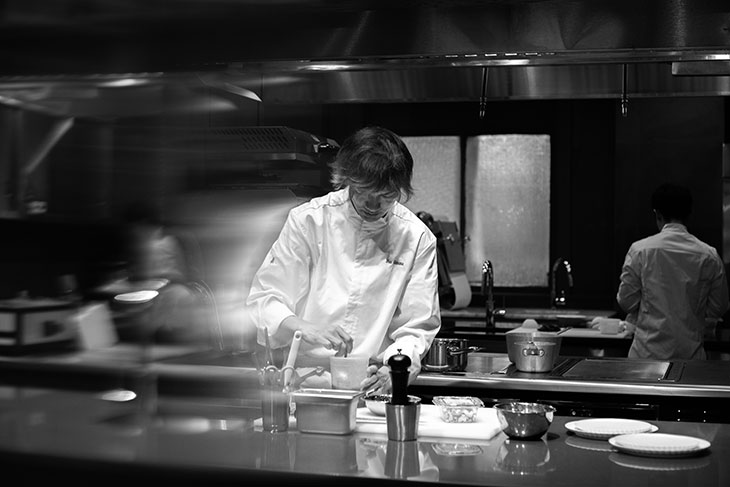
The evening at Restaurant YUU begins with an air of ceremony: the lights dim, curtains are drawn back, and the entire kitchen team is revealed, dressed in stark whites, standing at attention. This theatrical introduction is the opening act of a carefully choreographed dining experience led by Chef Yuu Shimano, whose classic French training and Japanese heritage combine to deliver an unforgettable fusion of elegance and boldness on the plate. Located in Greenpoint, Brooklyn—an area known for its mix of tranquil atmosphere and vibrant youth culture—Restaurant YUU offers an intimate setting with only 18 seats, providing an exclusive experience to 36 diners each evening.
RESTAURANTS
Chef Yuu Shimano’s approach is a seamless marriage of French culinary tradition and Japanese “omotenashi,” the spirit of genuine hospitality. His latest offerings include a range of exquisite dishes, starting with delicate combinations like trout served with roe, fennel, and lemon, and continuing with more indulgent plates such as Nisqually oyster paired with bone marrow and shallot. The progression moves effortlessly through innovative combinations—sugar snap peas with cured duck and caviar, and heirloom tomatoes with king crab and gazpacho—delighting diners with each course.
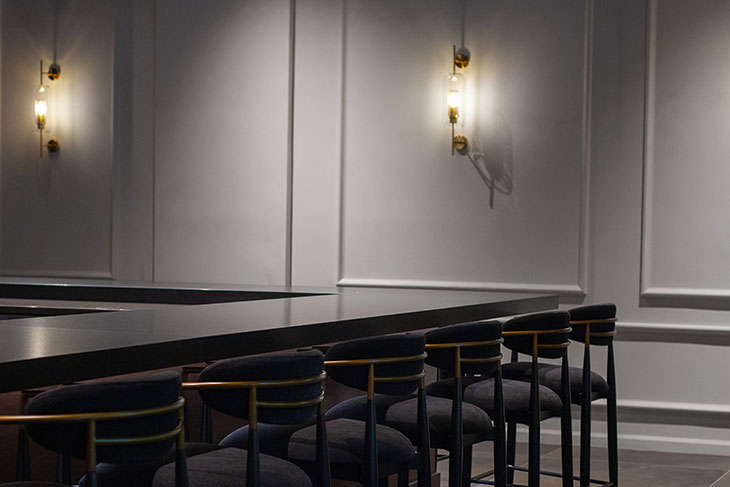
A highlight of the experience is the main course, where guests can choose between lamb served with asari clam and lemongrass, or guinea fowl paired with foie gras and morel mushrooms. The signature Canard—a dry-aged duck breast served with minced duck leg and an intense black pepper cognac and foie gras reduction sauce—pays homage to Chef Shimano’s roots in classic French cuisine while pushing the boundaries with bold flavors and exquisite presentation. To finish, desserts like crown melon with white port and a playful rum-infused donut peach offer a sweet conclusion that embodies both modern flair and culinary sophistication.
The warehouse-chic space, imbued with a sense of intimacy, provides the perfect backdrop for the culinary narrative that unfolds. Every element—from the dimmed lighting to the silent focus of the kitchen team—serves to enhance the sense of occasion, turning each meal into an immersive experience. As Chef Shimano and his team bring their vision to life, guests are invited not just to dine, but to witness and be part of a culinary performance that redefines fine dining.

Chef Yuu Shimano sits down with editor Katarina Doric to discuss the creative process behind his renowned dishes at Restaurant YUU. From the inspiration behind his culinary performances to the journey of blending French techniques with Japanese traditions, Chef Yuu shares insights into the storytelling and meticulous craftsmanship that define his work. He explores the bold innovations behind his signature dishes and the seasonal ingredients that bring his 16-course omakase to life, offering an intimate look at the artistry that makes Restaurant YUU a truly unique dining experience.
Restaurant Yuu has quickly gained recognition, earning a Michelin star within six months and topping various prestigious lists. How do you feel about this success so early in the restaurant’s journey? – Of course, earning a Michelin star was one of our goals from the time we opened, so I was honestly very happy. However, based on my experience, I also felt the challenge of it all. As a Japanese chef doing French cuisine in New York, it’s a different stage than offering something like Japanese kaiseki or sushi. I felt a lot of pressure because of that. So, I feel deeply honored to have been awarded a Michelin star.
View this post on Instagram
Your recent travels to Japan inspired the new autumn menu. Can you share specific moments or experiences from your trip that deeply influenced the creation of certain dishes? – My background includes eight years in France and eight years in New York, so I didn’t have many opportunities to eat Japanese cuisine. This time, in my position as owner-chef of my own restaurant, I was able to experience traditional Japanese kaiseki and sushi from a fresh perspective, particularly at Michelin three-star and two-star establishments. I felt like I got a glimpse of the essence of Japanese cuisine.
What stood out to me was the focus on the seasons, serving the best ingredients at their peak – something we also emphasize in New York. It reinforced the idea that my approach to showcasing my identity and history in my dishes was aligned with this. This realization was the most significant takeaway from my trip.

Restaurant Yuu offers a 16-course omakase experience that blends French technique with Japanese principles of omotenashi. How do you balance these two culinary worlds in a way that feels natural and seamless? – This is the most challenging question, and it’s something we are constantly experimenting with. It’s not simply about balancing the two worlds (French technique and Japanese principles of omotenashi); rather, we are in the process of creating our own unique fusion at Restaurant Yuu. As I mentioned earlier, it’s about capturing the feeling of Japanese cuisine and integrating it in a way that makes sense within our approach. In a way, we are creating a new history and culture.
We’re still in the process of finding our own answer, and we continually explore how best to achieve this. Ultimately, how it resonates depends on the experience of our guests.
I believe chefs are not only creators and artists, but also performers. It’s important for us to be seen by our guests, to be in that visible position.
The plating of each dish is a key part of the dining experience at Restaurant Yuu, with pottery and woodwork from Japanese artisans like Arita Plus and Aya Morishita. How important is the visual presentation of your dishes, and how do these materials enhance the storytelling of each course? – As a chef, I see myself as a craftsman, and I believe in using items crafted by Japanese artisans in our presentation. Whether it’s music or something more tangible, the things that support and uplift us are important, and for us, the plates and serving dishes are the clearest example of this. It was something I wanted to highlight even before opening the restaurant.
The storytelling of each dish comes through in the presentation, not just in the ingredients but also in the plates and utensils crafted by specific artisans. When we serve a dish to the guests, there’s always a sense of pressure, but knowing that we have the support of these talented people – whether it’s the artisans behind the plates or the producers of the ingredients – gives us a sense of confidence, almost like a good luck charm. I believe this connection comes through to our guests as well.
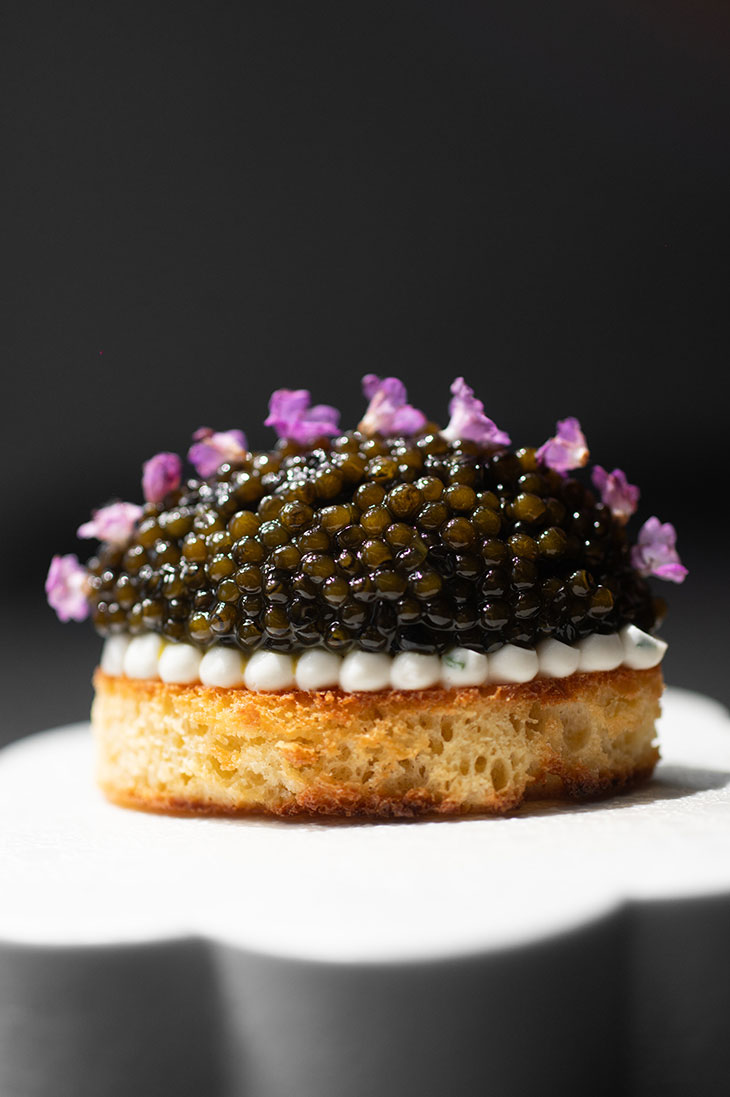
Your signature Duck en Croute has become one of the standout dishes on the menu. Could you walk us through the process of crafting this dish, from the aging of the duck to the daily creation of the pie shell? – This dish has been one I’ve wanted to create ever since I decided to open my own restaurant, and it’s incredibly complex. The reason is that it’s impossible to make on my own. It’s a collaboration between myself and our Executive Pastry Chef, Masaki Takahashi, who crafts the pastry shell. Each step in the process is intricate, and not only do we age the duck, but we also carefully control the level of aging and moisture, which is the first big challenge. This part requires my expertise.
The texture of the duck legs, combined with cream cheese, mushrooms, and eggs, requires a precise balance. The moisture levels shift depending on the ingredients we add, which was a challenge we had to address in perfecting the recipe. We use three to five different types of seasonal mushrooms, and these, along with other ingredients like shallots, parsley, and garlic, are sautéed in garlic oil or garlic butter for optimal flavor before being placed into the pie.
Even the spinach is treated with care – each leaf is cleaned thoroughly and arranged meticulously in the same direction. Our team spends hours every morning on this process. It’s truly a dish that the whole team comes together to create. The pastry Chef Takahashi makes is thin and the flour blend was something we’ve paid attention to since the restaurant opened. His artistic vision is expressed in the decorative touches of the pie every day. I truly believe it’s the best pie dish in New York.
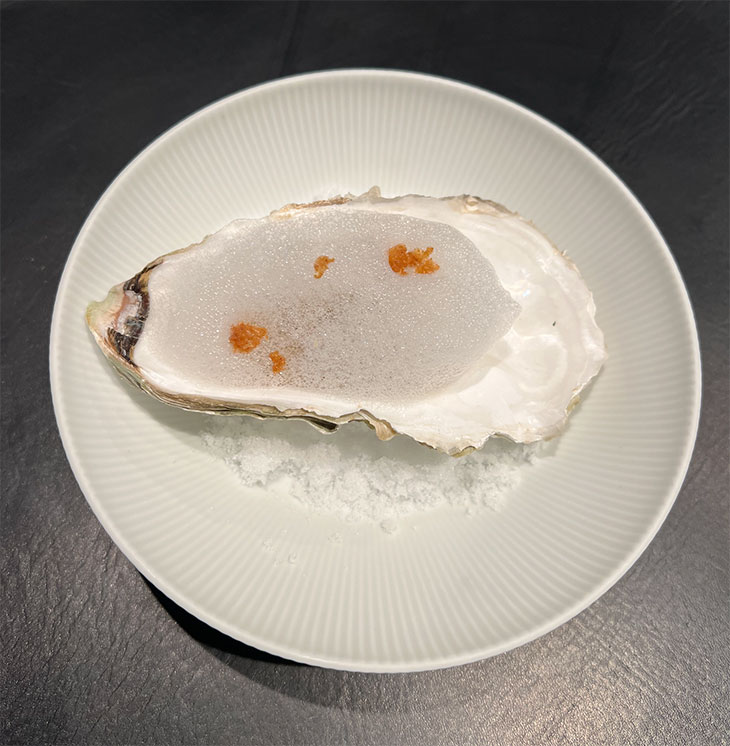
The restaurant’s open kitchen creates a sense of theater for your guests, with you and your team working in full view. How does this dynamic impact the dining experience, and do you think it adds an extra layer of connection between the chefs and diners? – I didn’t have many opportunities to eat sushi or kaiseki growing up, but once I started to experience it, I noticed that sushi chefs, for example, serve the rice at the perfect temperature and slice the fish in front of the guest, rather than preparing it in advance. I thought it would be interesting to bring that level of immediacy and freshness into French cuisine.
Even though French cooking is complex, I’ve been thinking for the past 7-8 years about how to create that excitement in my own restaurant, where guests can watch and wonder, “What’s coming next?” as the chefs work in front of them.
Additionally, I think about the role of chefs in society. It may sound a bit grand, but I believe chefs are not only creators and artists, but also performers. It’s important for us to be seen by our guests, to be in that visible position. I think that in the future, this should become more common, and part of the message we convey is exactly that. So, when guests come to the restaurant, I’d love for them to not only think of it as a meal, but almost like an admission fee to a performance. That would make the experience even more exciting.
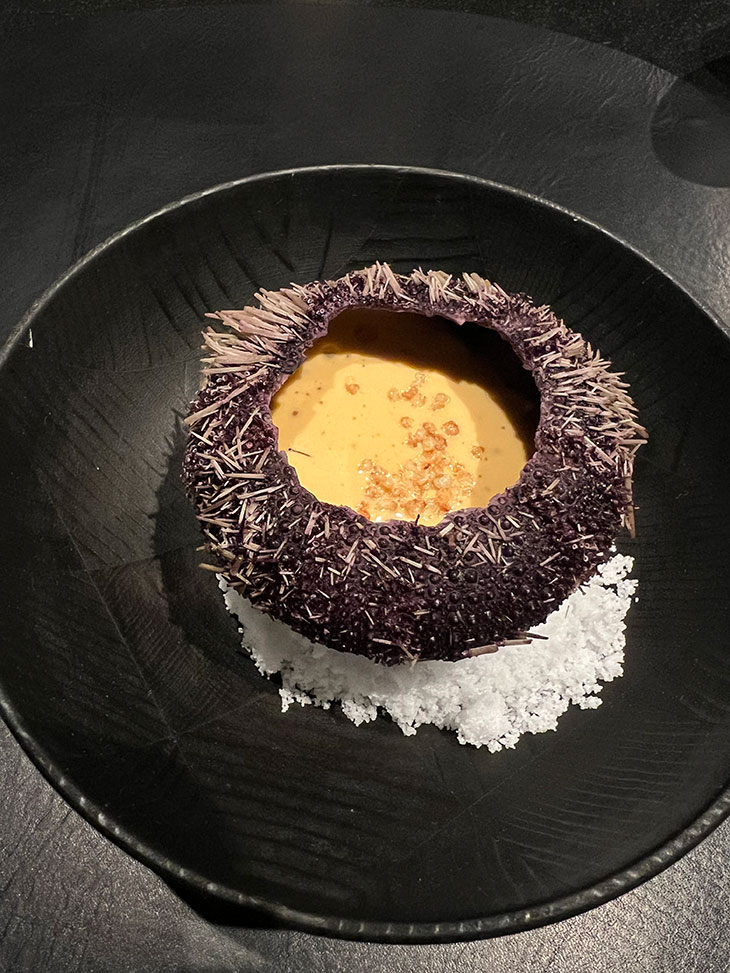
What are your favorite ingredients to work with? – Seasonal vegetables always excite me. As a chef, seasonal ingredients inspire me the most, making me think, “I have to create something with this.” It’s the seasonal products that spark my creativity. That said, given my background, I’ve worked a lot with meat dishes, especially with our signature ingredients like duck, foie gras, and lamb—classic elements of French cuisine. I’m always particularly focused when working with those. But I also love seafood, so in the end, I don’t think I have a single favorite ingredient. That’s what being a chef is all about—loving all ingredients.
As a chef, you’re constantly creating new experiences for others through your dishes. When you’re the one dining out, what type of cuisine or restaurant excites you the most, and what do you look for in a meal as a guest? – I love delicious food. While I appreciate a chef’s philosophical or religious approach to cooking, I also have a deep love for classic French cuisine and traditional Japanese food. I enjoy innovation, but as a meal, I’m especially drawn to regional dishes or foods that you can only experience in certain places. Those are the meals that excite me the most.

Culinary trends are always evolving, but many chefs find inspiration from unlikely sources. Outside of the kitchen, what art forms, hobbies, or life experiences inspire your creativity and influence your approach to cooking? – Having spent nearly 20 years abroad, I’ve found inspiration from meeting people in professions I wouldn’t have encountered while in Japan—artists, models, people in fashion, creators, and musicians. I make a conscious effort to engage with these types of creatives. Hearing how they stay motivated and approach their work often pushes me forward as well.
Personally, I’ve always been into soccer, so I’m fascinated by how top athletes maintain their motivation. Take Cristiano Ronaldo, for example—his discipline with diet, sleep, and training, and the sacrifices he makes to stay at the top are inspiring. Hearing about these sacrifices from those who excel in their fields gives me motivation, and I actively seek out those kinds of stories.
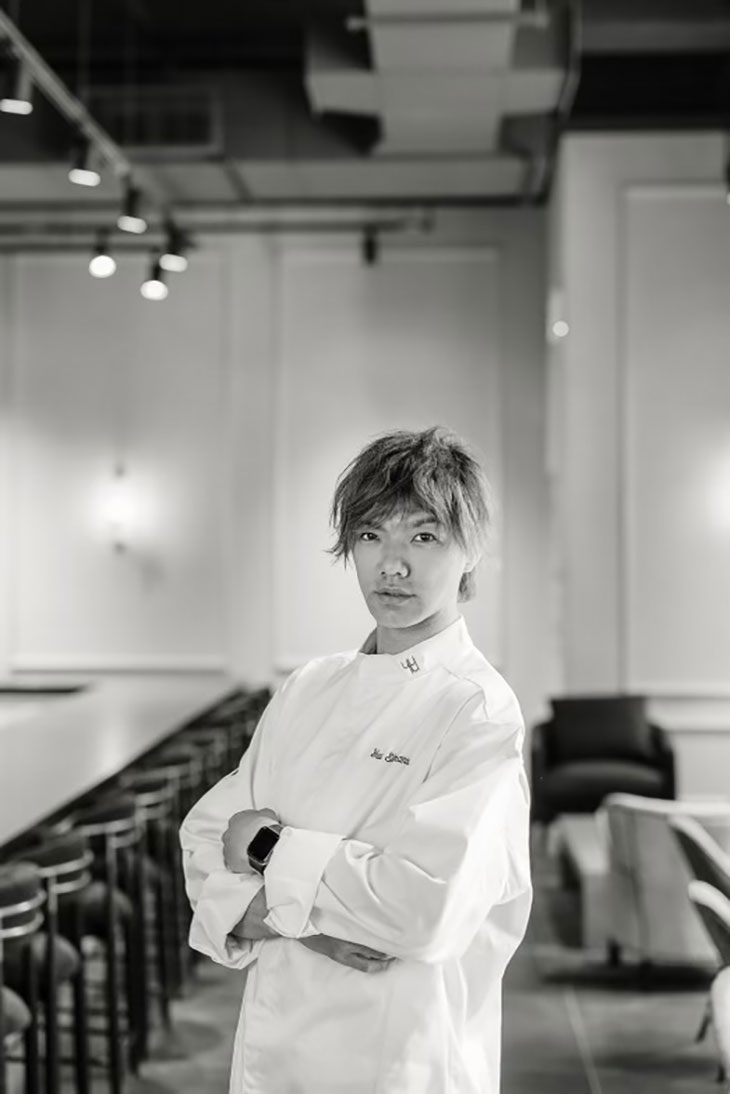
What are your plans for the future? – The most straightforward goal is to aim for two Michelin stars. If there’s a chance, I’d also like to achieve recognition from rankings like The World’s 50 Best Restaurants or La Liste. When we earned our first Michelin star, I experienced the shared happiness within the team, and I’d love to aim for that again as we continue to move forward together.
At the same time, as a business owner, it’s essential for me to run the business well and turn my aspirations into a sustainable venture. Another goal is to elevate the social status of chefs, particularly Japanese chefs, which has become a personal mission of mine.
Keep up with Restaurant YUU and Chef Yuu Shimano on Instagram – @restaurant_yuunyc @yuushimano
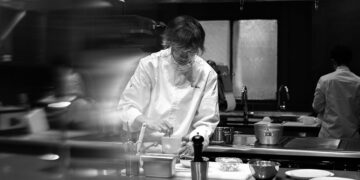



















wow! this is simply said AMAZING!